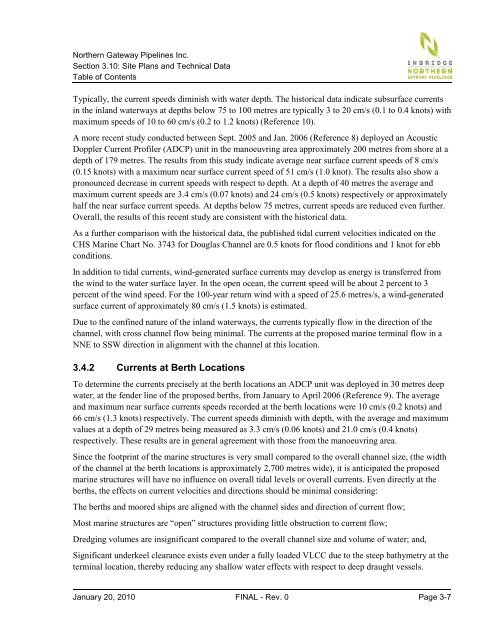Section 3.10: Site Plans and Technical Data - Rick Neufeld Comments
Section 3.10: Site Plans and Technical Data - Rick Neufeld Comments
Section 3.10: Site Plans and Technical Data - Rick Neufeld Comments
You also want an ePaper? Increase the reach of your titles
YUMPU automatically turns print PDFs into web optimized ePapers that Google loves.
Northern Gateway Pipelines Inc.<br />
<strong>Section</strong> <strong>3.10</strong>: <strong>Site</strong> <strong>Plans</strong> <strong>and</strong> <strong>Technical</strong> <strong>Data</strong><br />
Table of Contents<br />
Typically, the current speeds diminish with water depth. The historical data indicate subsurface currents<br />
in the inl<strong>and</strong> waterways at depths below 75 to 100 metres are typically 3 to 20 cm/s (0.1 to 0.4 knots) with<br />
maximum speeds of 10 to 60 cm/s (0.2 to 1.2 knots) (Reference 10).<br />
A more recent study conducted between Sept. 2005 <strong>and</strong> Jan. 2006 (Reference 8) deployed an Acoustic<br />
Doppler Current Profiler (ADCP) unit in the manoeuvring area approximately 200 metres from shore at a<br />
depth of 179 metres. The results from this study indicate average near surface current speeds of 8 cm/s<br />
(0.15 knots) with a maximum near surface current speed of 51 cm/s (1.0 knot). The results also show a<br />
pronounced decrease in current speeds with respect to depth. At a depth of 40 metres the average <strong>and</strong><br />
maximum current speeds are 3.4 cm/s (0.07 knots) <strong>and</strong> 24 cm/s (0.5 knots) respectively or approximately<br />
half the near surface current speeds. At depths below 75 metres, current speeds are reduced even further.<br />
Overall, the results of this recent study are consistent with the historical data.<br />
As a further comparison with the historical data, the published tidal current velocities indicated on the<br />
CHS Marine Chart No. 3743 for Douglas Channel are 0.5 knots for flood conditions <strong>and</strong> 1 knot for ebb<br />
conditions.<br />
In addition to tidal currents, wind-generated surface currents may develop as energy is transferred from<br />
the wind to the water surface layer. In the open ocean, the current speed will be about 2 percent to 3<br />
percent of the wind speed. For the 100-year return wind with a speed of 25.6 metres/s, a wind-generated<br />
surface current of approximately 80 cm/s (1.5 knots) is estimated.<br />
Due to the confined nature of the inl<strong>and</strong> waterways, the currents typically flow in the direction of the<br />
channel, with cross channel flow being minimal. The currents at the proposed marine terminal flow in a<br />
NNE to SSW direction in alignment with the channel at this location.<br />
3.4.2 Currents at Berth Locations<br />
To determine the currents precisely at the berth locations an ADCP unit was deployed in 30 metres deep<br />
water, at the fender line of the proposed berths, from January to April 2006 (Reference 9). The average<br />
<strong>and</strong> maximum near surface currents speeds recorded at the berth locations were 10 cm/s (0.2 knots) <strong>and</strong><br />
66 cm/s (1.3 knots) respectively. The current speeds diminish with depth, with the average <strong>and</strong> maximum<br />
values at a depth of 29 metres being measured as 3.3 cm/s (0.06 knots) <strong>and</strong> 21.0 cm/s (0.4 knots)<br />
respectively. These results are in general agreement with those from the manoeuvring area.<br />
Since the footprint of the marine structures is very small compared to the overall channel size, (the width<br />
of the channel at the berth locations is approximately 2,700 metres wide), it is anticipated the proposed<br />
marine structures will have no influence on overall tidal levels or overall currents. Even directly at the<br />
berths, the effects on current velocities <strong>and</strong> directions should be minimal considering:<br />
The berths <strong>and</strong> moored ships are aligned with the channel sides <strong>and</strong> direction of current flow;<br />
Most marine structures are “open” structures providing little obstruction to current flow;<br />
Dredging volumes are insignificant compared to the overall channel size <strong>and</strong> volume of water; <strong>and</strong>,<br />
Significant underkeel clearance exists even under a fully loaded VLCC due to the steep bathymetry at the<br />
terminal location, thereby reducing any shallow water effects with respect to deep draught vessels.<br />
January 20, 2010 FINAL - Rev. 0 Page 3-7
















